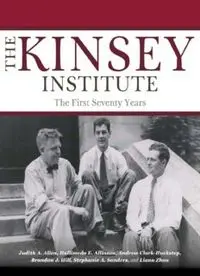
The Kinsey Institute The First Seventy Years PDF
Preview The Kinsey Institute The First Seventy Years
The Kinsey Institute KINSEY INSTITUTE The First Seventy Years JUDITH A. ALLEN HALLIMEDA E. ALLINSON ANDREW CLARK-HUCKSTEP BRANDON J. HILL STEPHANIE A. SANDERS LIANA ZHOU INDIANA UNIVERSITY PRESS THE This book is a publication of Indiana University Press Offce of Scholarly Publishing Herman B Wells Library 350 1320 East 10th Street Bloomington, Indiana 47405 USA iupress.indiana.edu © 2017 by Indiana University Press All rights reserved No part of this book may be reproduced or utilized in any form or by any means, electronic or mechanical, including photocopying and recording, or by any information storage and retrieval system, without permission in writing from the publisher. The Association of American University Presses’ Resolution on Permissions constitutes the only exception to this prohibition. The paper used in this publication meets the minimum requirements of the American National Standard for Information Sciences—Permanence of Paper for Printed Library Materials, ANSI Z39.48–1992. Manufactured in the United States of America Cataloging information is available from the Library of Congress. ISBN 978-0-253-02976-8 (cloth) ISBN 978-0-253-03023-8 (e-bk.) 1 2 3 4 5 22 21 20 19 18 17 frontispiece: Alfred Charles Kinsey. Clarence Tripp took this photograph around the time that Sexual Behavior in the Human Male was published, ca. 1948. Photo courtesy of Kinsey Institute Library and Special Collections. For Wendy Kinsey Corning Contents Acknowledgments ix List of Abbreviations xiii Introduction: Looking Back 1 1 • Overlapping Foundations (1916–1946) 13 2 • Making the Kinsey Reports (1947–1956) 37 3 • Finishing the Mission (1957–1965) 70 4 • Navigating Sexual Revolution (1966–1981) 98 5 • Initiating Paradigm Shifts (1982–1993) 133 6 • Turning Outward (1994–2016) 154 Conclusion: Looking Forward 179 Notes 189 Appendix A: Selected Publications by Kinsey Institute Researchers and Affliates by Decade 217 Appendix B: Selected Scholarly Works, Kinsey Institute Library and Special Collections 259 Index 265 Acknowledgments It is a pleasure to have so many people to thank for this short history reaching frui- tion. None of us realized that this project was in our futures. Sue Carter, director of the Kinsey Institute, wanted to mark, for 2017, the seventieth anniversary of the Institute’s founding. The historians amongst us realized promptly that exist- ing Kinsey biographies or histories of American sex research did not suffce for the purpose. Too many unanswered questions loomed, and, it seemed, too much missing evidence prevented us from providing convincing explanations of key mat- ters. Whose idea was it to found the Institute? Was it Indiana University’s reliably visionary new young leader, President Herman B Wells? Was it Kinsey himself? What was its founding rationale or purpose? How was it structured, governed, and resourced? How did the university town of Bloomington, the state of Indiana, and the United States respond to this institutionalization of the feld of sex research, hitherto of European rather than American genealogy? Further, if earlier Kinsey biographies and the 2004 Bill Condon movie, Kinsey, provided some sense of the Institute’s research activities while it was led by Kinsey, the period from his 1956 death until the present, for most people, was much less clear. Several researchers had done previous work touching one way or another on the story of the Institute’s founding, early work, and activities. A seventieth- anniversary assessment, though, warranted something more systematic. It involved searching from top to bottom not only the Institute’s extensive germane collections but also the Indiana University Archives, President Herman B Wells’s papers and correspondence, the archives of the Rockefeller Foundation and other granting bodies, and the papers of key fgures in American sex research and related clinical felds in Boston, Cambridge, New York, Philadelphia, and Washington, DC. These efforts garnered new documents, images, and texts. Some of this information came to be used for hallway display in the Institute premises and for booklets for visi- tors, guests, and sponsors of the Institute’s work and collections. ix
